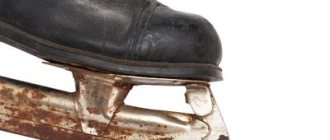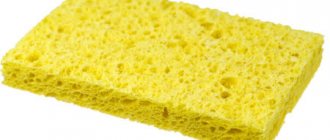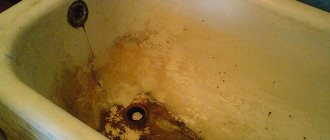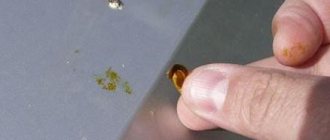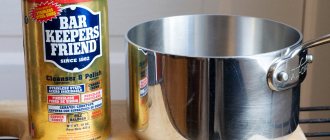Improper storage of your bicycle, improper care of it and inappropriate use - these factors lead to the fact that over time traces of corrosion may appear on your bike. This is an extremely unpleasant phenomenon that affects almost every metal part of the bicycle, starting from the chain and ending directly with the frame. And, if minor traces of rust on the chain can be removed by basic cleaning or simply replacing a consumable part, then you will have to tinker with the frame. Today we’ll talk about how to remove rust from a bicycle, and what methods you can use to eliminate corrosion at home.
Rust removal methods - which is the most effective?
What areas are most likely to rust?
Oddly enough, the frame is the last stage, and if it deteriorates, it means that everything else has long been neglected. Most often, corrosion forms in the wheels, front fork, under the saddle, and at metal joints. There are three common methods:
- Electrode.
- Cleaning with orthophosphoric acid based products.
- Homemade: weak acids and soda solution.
The electrode method is interesting because after treating the surface, it is covered with an anti-corrosion layer, after which it will never rust. Allows you to get rid of deep oxide damage. It especially shows its qualities on large surfaces, such as a frame or rim.
To work you will need:
- Battery;
- small zinc plate;
- soldering acid;
- the wire;
- self-tapping screw;
- 12 V light bulb;
- cotton wool;
- rags;
- dielectric gloves.
We will assemble a circuit by constructing an electrode with an electrical circuit. Stages of work:
- Clean, degrease and dry all rusty surfaces/parts.
- Wrap the zinc plate in cotton wool and rags (let's make a so-called tampon).
- Thread a self-tapping screw through the cotton wool so that its tip touches the zinc plate.
- Connect the wire with a self-tapping screw, a light bulb and a battery.
- The swab is moistened in soldering acid and applied to the oxidized areas.
All work is done wearing dielectric protective gloves.
The "house acid" method is a great alternative to assembling an electrical circuit. Suitable reagents:
- citric acid (or lemon/lime juice);
- a mixture of acetic and citric acids in a 1:1 ratio;
- not an acid, but also an effective remedy - a solution of baking soda (acidic salt).
It would seem that everything is very simple: pour acid on the rust. But in practice everything looks different. So:
- Clean and degrease the surfaces with fine sandpaper.
- We change the sandpaper sheet and carefully apply droplets of acid to it.
- Wet the rust area with the sanding surface and rub it in with a little force.
- Washing with water. Water removes traces of acid, which would later corrode the metal (which is worse than rust). We go over all treated areas with a clean dampened rag, then wipe it dry and leave it in a ventilated, dry room. You can take it out into the sun.
This method is effective for moderate lesions. Well suited for sprockets, steering wheels, rims, spoke tips.
Removing rust using a special product. The compositions contain a fairly strong reagent - phosphoric acid. They are suitable if the depth of the lesions is not deep enough. Although some more aggressive compounds also remove serious corrosion defects. The work progress is similar to removal using the second method - preparing surfaces, applying the compound to the grinding surface, gently rubbing in the compound and washing. It is advisable to carry out the work wearing gloves and a medical mask.
Such products are sold in cans in specialized stores. For most careful bicycle owners, these products are an easy way to prevent rust from occurring.
To summarize: which of these methods is the best? Of course, the most effective way to remove corrosion is by the electrode method. At the same time, the second and third methods will be the most accessible for a person at home. And the latter will even benefit, since it will even save time on preparing the composition.
Chemical method using special materials
One of the most effective is the removal of corrosion using special converters. Having a specific composition, they are able to almost completely remove plaque from initial stage damage.
Cleaning can be done outdoors in sunny and dry weather. You can work in the garage and even on the balcony with the door to the apartment closed. The procedure requires the product itself. It is sold in aerosols or simple bottles. You should also prepare rags; a respirator and rubber gloves will be useful for personal protection. To avoid leaving marks during work, it is worth covering the area with thick polyethylene. The process itself is carried out according to the following algorithm:
- Removing dirt and dust from areas to be treated.
- Degreasing and drying them.
- Applying a thin layer of converter.
- Give time for the chemical process. It is indicated on the packaging.
- Wipe well with a clean cloth.
If the rust still remains on the bicycle, you should perform the manipulation again or try other cleaning methods.
Take care of your bike
The occurrence of rust on a bicycle is associated with direct contact of water with metal, air humidity, and improper care of the mechanisms. Unlubricated and dirty parts are more susceptible to corrosion, so clean, lubricated and dry surfaces are key to long service life.
Riding in rain and mud. No one is safe from it, and some cyclists like to spend their time this way
It is important to remember that wet parts are highly susceptible to oxidation. Especially in hard-to-reach places where moisture accumulates. To prevent the bike from rusting, after a ride in the rain, we wipe and dry everything.
To prevent the bike from rusting, after riding in the rain, we wipe and dry everything.
Storage in a damp place. This is even more dangerous than driving in the rain. High humidity literally penetrates every part of the bike, which can result in several large areas of corrosion. Store your bike in a spacious, warm, dry place. As for storage rooms, they need to be ventilated periodically by taking the bike outside.
Incorrect washing. Wash the bushings, system, carriage, wheels so that no water gets inside. Rust especially “loves” to accumulate in wheel hubs, under spoke tips and generally at any joints. After washing, it is recommended to wipe the bike dry or dry it in the sun.
But what to do when rust does occur? In fact, removing it is not such a problem. What methods exist and how to do it - read on.
Prevention
As you know, the best way to solve a problem is to prevent it. Rust on metal is no exception, because corrosion processes can be avoided or at least delayed as much as possible. To do this, you need to follow preventive measures, namely:
- Wipe all parts of the bicycle dry after washing it or riding in the rain.
- Store the vehicle in a case or dry place.
- Lubricate moving parts with machine oil.
- Periodically repaint the frame.
- Maintain nickel and chrome plating.
Folk remedies for rust removal
There are several methods that explain how to remove rust from a bicycle. Their advantage is their relative simplicity and low material costs.
Vinegar and citric acid
These reagents are excellent at removing rust, but prolonged exposure of the mixture to the metal only increases corrosion, so you need to do everything quickly.
First, you need to prepare the materials. You will need 9% vinegar and citric acid in equal proportions. They mix and form a powerful working mixture. Pressed steel turnings are also needed. If you can’t find it, then you can limit yourself to fine-grained sandpaper. You will also need napkins or rags.
Preparing the material does not take much time. A small amount of the mixture should be poured onto the sanding material to make it wet. But it shouldn't leak. Also, before removing corrosion, you need to turn the bike upside down and secure it in a stable position.
You need to remove rust with light movements, as if erasing plaque - smoothly and without sudden movements. Sometimes beginners don't understand how to remove rust from a bicycle chain. This is not difficult if you properly prepare the solution and materials for cleaning.
It is important to remember that you cannot keep the mixture on the metal for a long time - after cleaning you need to immediately proceed to the washing and drying stage
Washing the bike is done with a damp cloth or soft paper. And while drying, you can rest a little and let the sun evaporate the moisture. Otherwise, you need to take a dry rag and wipe the bike until traces of water and mixture remain on the rag.
Top articles : Gravel bikes (gravel bikes)
Cola
Using Coca-Cola to clean your bike may seem strange. But if the chain on a bicycle is rusty, what should you do? You have to resort to such methods.
In fact, the drink contains phosphoric acid, which eats away corrosion. You just need to apply it to the rust, leave it for 10-15 minutes and wipe it off with a damp cloth.
Lemon and salt
The rim and steering wheel are effectively cleaned of corrosion using salt dissolved in lemon or lime juice.
This will require 6 tbsp. l. salt and 2 tbsp. l. citrus juice. After applying the mixture, you need to wait and then rinse the cleaned parts.
Features of cleaning in hard-to-reach places
Now let's talk about thorough cleaning, which is necessary in cases where the bicycle is rusty, as they say, “from start to finish.” Here it would be a good idea to completely disassemble the bike down to the smallest detail, or partially, without removing the transmission.
The first thing you need to do is clean your bike frame. Particular attention (except for obvious areas of damage) should be paid to the internal cavities of the seat tube, carriage and steering tubes. Often traces of corrosion can be found on the steering wheel and the sliding mounting cone, along with the inner walls of the column. This is due to a lack of lubrication and moisture getting inside the fork.
Transmission elements - sprockets, metal pedal frames, chain - all this is cleaned separately from the bicycle. In any case, these parts will have to be removed.
Hard-to-reach places (for example, chain, nuts, sprockets, etc.) are easier to soak in anti-corrosion solutions, observing all precautions and maintaining time limits. You can remove rust from the nickel-plated surface of a bicycle with citric acid if the damage is minor. And remember that after cleaning, you should protect the metal part from further rust.
Causes of rust on a car body
There are two types of car corrosion:
- Chemical
_ This implies contact of the metal with a dry air flow in a liquid that is not classified as an electrolyte (distilled water). With chemical corrosion, oxidation of the metal surface occurs, followed by the appearance of a film on it. - Electrochemical
. This process is characteristic of the heterogeneity of two elements (in the physical and chemical sense) - the metal and the environment. The role of the electrolyte is played by a liquid mixed with salt, as well as the “chemistry” that is sprinkled on the road surface.
As for the reasons that lead to the appearance of rust on the metal surface, there are several of them:
- The presence of alloying elements in the metal
. They differ in their susceptibility to oxidative processes. The more of them there are in the composition, the faster rust forms on the surface. - Humidity level
. If wet weather (rain, fog) prevails in the region where the vehicle is operated, then corrosion problems “pop up” faster. Thus, car enthusiasts living in the subtropical zone are more likely to encounter the problem of corrosion on the body than their “colleagues” from regions located in the equatorial zone. - Temperature changes
. Experienced car enthusiasts should understand that condensation is the main enemy of a car body. The problem arises when entering a warm room from a cold street. The accumulation of moisture occurs due to a sharp change in temperature difference. If the holes in the thresholds are not contaminated with debris, the liquid will drain and will not cause harm. Otherwise, water lingers near the thresholds and promotes corrosion. - Quality of road surface
. When driving on a flat and clean road, the car body does not experience additional mechanical stress. It’s another matter when there are a lot of small stones on the surface that hit the body and knock off the protective layer (paint, primer). If the road is treated with a special reagent designed to prevent slipping, the metal will rust faster.
Rust on a bicycle or how to avoid metal corrosion
10.04.16
Corrosion on a bicycle is a fairly common defect that occurs over time. Rain, high humidity, snow and other environmental phenomena affect this process. Traces of corrosion appear as a result of the action of water, oxygen and carbon dioxide on metal surfaces. That is, a reaction occurs with the formation of iron oxides and hydroxides.
Traditional methods of fighting rust
Most often there are recommendations for using citric acid for these purposes. Indeed, almost everyone has it at home, and lime juice can serve its role. Just squeeze the citrus into a suitable container and you’re ready to start. Additionally, you will need sanding material, unnecessary rags or paper towels. All you have to do is take a few simple steps:
- Apply acid to sandpaper, steel wool or wire brush;
- Rub sanding material with applied liquid over the surface of the bicycle. Carefully go through all the places, not forgetting about the fasteners and other small elements.
- Get rid of the applied acid, because if it remains, it will corrode the surface. Carefully rinse all parts.
- Dry thoroughly and it is better to do this several times. You can wipe it with a rag the first time, and then walk over the surface with paper napkins.
- Don't forget to lubricate all elements responsible for movement. Apply gel or any other lubricant until the chain is treated.
Identical actions can be performed using a combination of vinegar and citric acid (in a 1:1 ratio) as a reagent. Or another proven option - a couple of tablespoons of soda, diluted in a glass of water.
WD-40 solution.
Be careful when handling your bicycle chain; it can easily be damaged. Use WD-40 solution for cleaning. You can place the chain in diesel fuel, kerosene or lubricate it with mineral oil for five minutes. After applying the oil, at least twenty minutes should pass so that it penetrates as deeply as possible. And only after that can the rust layer be removed. And then remove any remaining oil with an absorbent sponge.
Phosphoric acid will remove rust from a bicycle
Orthophosphoric acid.
This substance is used in many industries and is an 85% solution
When working with it, it is very important to follow safety precautions. The product is flammable and quite toxic
But if you handle it correctly, it will cope with traces of corrosion more effectively than others. What you should do: choose a room that is easy to ventilate, open the windows, wear gloves and a mask (preferably a respirator). Avoid contact with exposed skin.
How to properly clean a bicycle with phosphoric acid:
- Remove large areas of rust mechanically. A metal brush or something similar is suitable for this;
- Degrease with soapy water;
- Apply acid in any way - brush, sponge, roller;
- After a couple of hours, wash with a neutralizer (ratio: 48% alcohol, 50% water, 2% ammonia);
- Wash with detergent
- Dry with a towel or cotton cloth.
Purchased funds
The so-called “rust converters” are made on the basis of the same phosphoric acid and special additives. The purpose of purchased drugs depends on what components are additionally included in the composition.
They are divided into: converters, primers, stabilizers. For example, converters with the addition of manganese and zinc will provide the effect of alloying the metal. Another type - primers can get rid of corrosion and serve as a base for painting. And modifiers-stabilizers themselves are not a primer; they only increase its properties and remove rust.
It's up to you to decide which product to choose. You can start with budget methods, using time-tested folk advice. If they do not completely cope with the problem or you want to improve the result, then try a store-bought product.
How to remove traces of oxidation
Rust can affect any metal parts of a bicycle
. Rust is an indicator of corrosion that occurs due to storing an item in areas with high humidity. First, small bicycle parts are involved in the process, then the frame suffers. If stains are found on it, then the remaining parts are most likely already very rusty.
First, the degree of damage is determined. Small spots that look like plaque can be removed with home remedies - baking soda and citric acid. But for larger and deeper damage, serious measures will be required - store-bought solvents and cleaners.
Small parts that can be removed are placed in a basin or bucket with the prepared solvent for 10-20 minutes. A bicycle chain can be cleaned of rust by other means - separately from other parts.
The anti-pollution algorithm is the same for all elements:
- Remove dust and dirt using a soap solution.
- Degrease and dry the parts.
- Apply a layer of the product to elements that cannot be immersed in a container with the solution.
- Leave for the time specified in the recipe.
- Clean with a napkin or cloth.
- Wash thoroughly and dry.
Only after the bike has completely dried do they evaluate the result of the work.
Rust removal is a process that requires compliance with safety precautions. Natural and chemical store-bought products are used for work. But when using any of them, wear protective gloves and a mask. All procedures are carried out in ventilated areas.
How to protect your bike from rust?
Otherwise, any contact not just with water, but even with fairly damp air leads to the formation of corrosion and, as a result, a reduction in the service life of a two-wheeled vehicle.
No one is safe from getting caught in the rain while cycling.
And if this happens, then it is important to take timely measures to prevent the process of oxidation of bicycle parts and structures. Particular care should be taken to wipe hard-to-reach places where moisture mainly collects.
Only completely dry can be left for storage.
Although modern bicycles are subject to high-quality painting, which effectively protects the bicycle from rust, microscopic scratches appear during use. They are not even visible to the eye, but they perfectly accumulate moisture and contribute to the development of the corrosion process. Especially if the bicycle is stored in a damp room. That is why the basic rule of maintenance is to store the bike in a dry and warm place.
Best articles: Bicycle rack on tow bar
A good owner tries to keep his iron horse in perfect condition. That is why washing is a mandatory and frequent manipulation. But it also requires proper implementation. You need to try to prevent water from getting inside the wheel hubs, at various joints, or in the area of the spoke tips. Wiping and complete drying are mandatory. It is these actions that will prevent your vehicle from turning into a pathetic, rusty bicycle.
Preventive protection of the body from rust
Knowing how to remove rust from a car is good, but it’s better to avoid such problems at all.
To do this, follow these tips:
- Wash your car regularly (including in winter, but of course not at sub-zero temperatures). Thanks to this, it is possible to remove the aggressive composition that is sprinkled on roads from the surface and thereby stop corrosion.
- Apply anti-gravel film to part of the roof and hood.
If this option is not suitable, as an alternative, although less effective, the use of a “fly swatter” is allowed. In this case, it is possible to protect the surface from the destructive effects of dust; it does not protect from small pebbles. - Regularly inspect the car in person or entrust this task to professionals. The sooner traces of corrosion are detected, the easier it is to eliminate them.
- Install mudguards and wheel arch liners on each wheel. This is the case where saving is inappropriate.
- Treat the bottom with a special anti-corrosion compound and then re-carry out the anti-corrosion treatment of the body every 5-6 years. The best option is to entrust this work to professionals.
Formation of rust on metal
The process of the appearance and development of rust on metal structures begins due to the appearance of an oxidative chemical reaction under the influence of strong dampness. The formation of corrosion is accompanied by deformation of the metal surface and destruction of the crystal lattice. There are several causes of iron rusting:
- Paint chips. The surface of many metal structures is covered with a protective layer of paint, which prevents moisture from contacting the iron. However, over time, the paint begins to peel off the product, which leads to corrosion.
- Scratches. Rusting of iron is facilitated by deep cracks on the surface.
- No anti-corrosion treatment. Experts advise treating metal with special anti-corrosion agents. If this is not done, the iron will gradually begin to become covered with a rusty coating.
Preventive measures
First, it’s worth understanding when and for what reasons rust appears on the metal elements of a bicycle. Here you don’t need to be a genius to compare obvious things. Imagine that you were caught in the rain on a bicycle or the bike stood alone under cold drops while you were enjoying a cup of aromatic coffee in a cafe. Upon arrival home, the bike needs to be wiped down and dried thoroughly. If this is not done, over time, rust will begin to corrode the metal parts. It is clear that after the first wetness, corrosion will not appear, but in a very short period of time (2-3 months is enough) if the bicycle is not handled properly, characteristic reddish spots will appear on its metal parts. There are three main reasons why this happens:
- Storing a bicycle in a damp place. Even in winter, it is not advisable to leave the bike on an unheated and unglazed balcony.
- Damage to the protective layer (detachment of the nickel or chrome coating that protects the metal from corrosion).
- Inadequate drying after water procedures.
Before we talk about how to remove rust from a bicycle, it is worth remembering that corrosion is a mixture of iron oxides and hydroxides. Rust appears directly from metal contact with water or air.
How to remove rust from chrome products
Every person encounters parts covered with a rusty coating. To return chrome elements to a beautiful shiny look, many use store-bought cleaners, which are very expensive. However, such an operation can be carried out by ordinary means that are used for economic purposes.
Products for removing rust from chrome plated products
Baking soda
To get started, you need to add baking soda to the water and stir thoroughly until you get a mushy mixture. It must be applied to the rusty surface and wait a few minutes. Then the soda is removed and the part is wiped well with a soft cloth.
Important! Don't let the baking soda dry out. It is strictly forbidden to leave the paste applied to the rusty area for a long time.
Dentifrice
The rusty, chrome-plated surface is wiped with a flannel cloth and powder. When the stains disappear, the remaining powder, along with the rust, is removed with a soft brush or cloth.
To use this technology, you will need carbonated drinks:
- sprite;
- Coca Cola;
- Fanta;
- Pepsi.
First, the chrome areas are wiped with a soft cloth to remove dirt. Each part is washed in warm water. Coca-Cola is moistened with food foil. The parts are sanded until the rust marks disappear. After the treatment, the areas are polished with felt until they shine.
Table vinegar – 9%
Take a plastic bag, fill it with vinegar and secure it to the part (for example, with a simple rubber band). For good cleansing, leave the bag overnight. If the size of the part to be cleaned allows, it can be placed inside.
On a note! The length of time the vinegar remains on the surface of the part depends on the size and depth of the corrosion.
Lemon juice with salt
To work, you need to mix salt with lemon juice, maintaining a 1:1 ratio. The damaged surface is wiped with a soft cloth previously soaked in the solution.
Paste GOI
The miraculous properties of this paste have been known for a long time. To combat rust, dilute with a few drops of any motor oil. The damaged surface is treated with felt soaked in this solution. Remains of rye are removed with a clean, slightly damp cloth.
Potato
The tuber is cut in half. The cut area of each half is rubbed with laundry soap. The potatoes are placed on a rusty surface and left for 3 hours. Remains of rye are removed with a damp cloth.
Copper sulfate
To work, you need to prepare a mixture consisting of several components:
- vitriol – 200 g;
- hydrochloric acid – 50 g;
- water - one liter.
All ingredients are thoroughly mixed. Use a swab dipped in the solution to wipe off rusty stains. After a few hours (2-3), a weak solution of baking soda is applied to the surface. Wait 15-20 minutes, wash off the residue with warm water, and dry well.
Note! To work with vitriol, hands should be protected with rubber gloves.
The operation requires extreme caution to ensure that the mixture does not come into contact with the skin.
Dry cement
This powder is considered a fine abrasive that can remove rust and also polish the surface well. The work must be performed in the following sequence:
Cement is applied to the rusty area. You can use felt.
Rusty areas are wiped especially thoroughly with felt.
The surface is degreased. Medical paraffin (wax) is melted in a metal container. A soft swab is inserted into it. After it is well soaked, it is taken out and excess wax is removed.
To make the surface shine again, it is rubbed with a wax cloth. The part will return to its original appearance.
WD-40
If severe corrosion is found on a chrome-plated part, you can use a Vedashka to restore it. Apply this product to the rusty area and wait 15 minutes. Then the surface is wiped with soft felt, returning the original shine.
How to remove rust from chrome plumbing fixtures
The rust control industry produces many special, highly effective cleaning products:
- Clin;
- Help;
- Rust solvent;
- "Mr. Muscle" and others.
The chrome surface should be wiped with any soft cloth. Baking soda is considered an excellent substitute for industrial detergent. Antistatic wipes are useful for removing soap scum.
To effectively remove rust from a chrome surface, it is enough to use any of the above methods. Home remedies are a great substitute for expensive cleaning products.
Cleaning a bicycle chain
This part of the bicycle should not be painted or cleaned with a wire brush, as it will quickly become unusable. To remove rust from a bicycle chain, proceed as follows:
- Remove the chain and place it in a metal container.
- Pour diesel fuel and put the pan on the fire.
- Bring to a boil and set the contents on fire.
- Remove from heat and pour onto stone surface.
- Wait until the chain cools down.
- Shake the chain until any remaining rust falls off.
- Lubricate with grease and install back.
Important! The procedure must be carried out outdoors using a fire. It is important to follow fire safety rules, as careless handling of fire can result in catastrophic consequences.
Chemical methods for removing corrosion
Of course, chemistry is a more aggressive way to combat rust. It is usually used for difficult situations where available materials may not work.
Orthophosphoric acid
It is quite difficult to work with because it is toxic and flammable.
For work you will need rubber gloves and a respirator for protection, napkins, soda and cotton pads to clean the bike. Also, the room should be well ventilated.
First, you need to rub the area to be treated with a brush or scraper and treat it with soapy water to degrease the surface. Next, phosphoric acid is applied using a cotton wool or roller.
Best articles: Disadvantages of Auchanbike
After 2-3 hours you will need a neutralizer that will remove the acid from the surface. His recipe: water, alcohol and ammonia in a ratio of 50:48:2. After this, the area is wiped with detergent and the bike is dried.
Other solutions
If the part requires careful handling, then you can use WD-40, kerosene or diesel fuel. These methods are suitable for cleaning the chain. It is enough to immerse the part in the product for 5 minutes, then lubricate it with mineral oil.
Cleaning a bicycle from rust is a necessary procedure for every cyclist. Fortunately, there is more than one cleaning method, so you can choose the most suitable one for the condition of your “iron horse”.
Removing small surface stains
How to quickly remove rust from metal?
It will take about half an hour to remove small surface rust stains. You must proceed as follows:
- Clean damaged areas with a brush or scraper.
- Lubricate them with mineral oil.
- Wait about twenty minutes.
- Remove the oil with the same scraper.
- Dry the bike with paper towels.
Methods for restoring and cleaning chrome parts from plaque and rust
Polishing chrome parts: general rules
Firstly, if you have a new car, you should clean the chrome plating in a timely manner. This will help you maintain the shine of chrome elements for a long time.
To clean and restore chrome plating, you will need a special product, which is sold in a car store or home remedies, which are listed below.
As a rule, the store-bought product is called chrome restorer or car shampoo with coating restorer. There may be other names, so check with the seller for information. Also purchase a coarse and soft sponge for washing.
For final polishing, you can use microfiber or a woolen cloth with a large pile.
Stock up on sponges and cleaning product and go ahead. The process is quite long. For example, one chrome rear bumper molding will require about 80 grams of cleaning agent and 2 sponges.
Once you have roughly cleaned the chrome finish, you can begin polishing the part. The polished part must be completely dry. For the best effect, it is recommended to use a hair dryer, microfiber or woolen cloth with a large pile.
When polishing, you can use a special polish for chrome. It will help avoid deposits on the coating and create a protective layer. Polishing is done in a circular motion, covering the entire surface.
After polishing, you need to leave the car for 30–40 minutes, and then go over the polished part again with microfiber to remove excess polish.
To maintain the ideal condition of chrome elements, it is necessary to carry out these operations 2-3 times a year. The effect that will be achieved will meet all your expectations.
How to remove rust from chrome car parts
In this case, it all depends on the size and depth of the corrosion spots on the chrome part. If the corrosion centers look like small rusty spots or scratches, this is half the battle, but if the corrosion center has already grown sufficiently and has an impressive depth, or the chrome has generally bulged, then it is practically impossible to save the coating or will not succeed at all.
Corrosion in the form of dots and scratches.
If a chrome-plated part has corrosion damage in the form of rusty spots with a shallow depth or scratches, then simple means are suitable for cleaning the surface and removing this rust: these are polishes, acetic or citric acid, soda, etc. The ideal option after this would be to coat the cleaned part with a protective polish to prevent the growth of former foci of corrosion.
Corrosion in the form of severe lesions or swelling.
If the chrome plated part has significant corrosion damage, it will be necessary to first clean it with very fine sandpaper, and then proceed to the method described above in the first case.
It is worth paying attention, if the chrome coating is completely swollen, then nothing can be done. You can only resort to special services that deal with chrome plating of parts
Or you can cover this part with a chrome film yourself.
This, of course, will not take much time, but still the effect will not be what you would like.
How to clean plaque on chrome car parts
Currently, there are quite a lot of products that can be used to clean and remove plaque from chrome car parts.
Moreover, it is important to mention that for this there is no need to run to the car store and spend money
And by the way, not every product for cleaning chrome elements will always cope with this. To some extent it will cope, but the cleaning process may take a long time. Therefore, below we will list the means that are probably in every home.
And this:
- Baking soda;
- Medical alcohol;
- Citric acid (especially effective);
- Acetic acid;
- Foil and water;
- Liquid for washing dishes or windows.
To keep the bike from rusting
Once you have removed the rust, you need to prevent further corrosion. The bicycle still remains in the air - which means it will interact with it. If you removed the rust with phosphoric acid, the bike will be protected from corrosion to some extent. If you used other means, you will have to take a few more steps:
- If the paint on the frame is peeling, paint it.
- Unpainted parts can be chromed or nickel plated - this is done in workshops.
- Lubricate parts that cannot be painted or chrome-plated with machine oil.
How to remove rust from metal at home?
How to remove rust from metal? There are many different ways to do this. The most effective are the chemical method using alkalis or acids, as well as the mechanical one.
Sometimes it is enough to remove rust with a stiff wire brush, as is often done with metal before painting. But you can’t just use a brush if the rust has eaten deep enough into the metal - then chemicals come to the rescue.
You can clean rust from metal using an auto cleaner, which can be purchased at any automotive supply store. First, you should clean the metal surface with a brush, then apply a layer of special paste 3-4 mm thick and leave for several minutes. At the end of the specified time, rinse off any remaining product and wipe dry. If the rust remains, the procedure can be repeated.
Minor rust can be removed with a wire brush or sandpaper, or wiped with a rag soaked in kerosene, machine oil or a special cleaner.
A solution that you can prepare yourself will also effectively help get rid of metal corrosion. To do this you will need:
- 300 ml water;
- 50 grams of caustic soda or caustic soda;
- 50 grams of ammonium;
- 250 grams of 40 percent formaldehyde.
The resulting product must be diluted in one liter of water. Rusted metal parts should be immersed in the prepared solution, which must first be cleaned and degreased. Depending on the degree of metal corrosion, parts can be kept in this solution for 15 to 35 minutes, periodically monitoring the process. If the rust has disappeared after 10 minutes, you can safely remove the part. After this procedure, rinse the metal with hot water and wipe dry - it will shine with its original shine again!
It can be easily found in auto parts stores or any other hardware section of the supermarket. Along with the anti-corrosion agent, it is rational to purchase a special primer that will ensure maximum “sticking” of the main product.
Chemical removal methods
The most effective are chemical methods for removing rust from metal. Therefore, in this article we will tell you about many such tools. We would like to warn you right away, dear friends, that this information will be more useful to your men, so now you can relax and watch your favorite TV series with a cup of coffee. Moreover, we also have some secrets of fighting corrosion in store for you, but more on that later.
So, let's look at the main
xcook.info
What rusts first?
If you forget about the bike and leave it on the balcony, then in 1-2 years it will become covered with rust. However, if you carefully examine the unit, you will be convinced that corrosion has appeared only on some parts. For example, the frame will not be damaged, since it is painted with a special paint that contains an anti-corrosion agent.
Parts that rust first:
- Metal parts of pedals.
- Chain.
- Spokes and iron parts of wheels.
- The steering wheel and its unpainted column.

